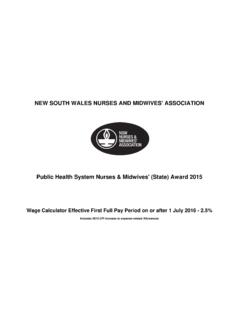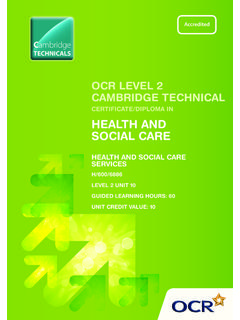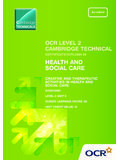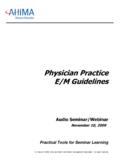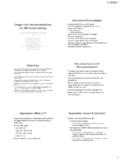Transcription of A Nurses’ & Midwives’ Guide to Reasonable …
1 1 A Nurses & midwives Guide to Reasonable Workloads committees Reasonable workloads are required for nurses to assist in providing a sustainable health system for the people of NSW that not only meets present health needs but also plans for the health needs of the future. The employer has a responsibility to provide Reasonable workloads for nurses. Clause 53(i) & (ii) of the Public Health System Nurses and midwives (State) Award It s there in black and white and it is clear that nurses and midwives have an entitlement to a Reasonable workload Judith Kiejda, Assistant General Secretary NSWNMA Version1 2014 2 Contents Contents .. 2 About This Manual.
2 3 First of all: Thank You for agreeing to be an employee representative on the local Reasonable workload Committee.. 3 The First Step .. 3 How are Minimum Staffing Arrangements Established? .. 4 Nursing Hours Per Patient Day (NHPPD) Ratios: .. 4 ACORN 2008 .. 4 Birthrate Plus .. 4 Peer Group D & F3 MPS .. 4 Inpatient Mental Health .. 4 Community and Community Mental Health .. 5 Emergency Departments .. 5 Monitoring Your Staffing Arrangements .. 6 Monitoring inpatient wards and units staffing levels .. 6 Spot Checks & the Nursing Hours Per Patient Day / Ratio Wards and Units .. 6 What is a workloads issue? .. 8 How to raise a Reasonable workload Concern at the ward or unit level?
3 9 What are some solutions? .. 10 What is a Reasonable Workloads Committee? .. 11 How do members contact the local Reasonable Workloads Committee? .. 12 What information is required and who provides it? .. 13 What is the process at a Reasonable Workloads Committee meeting? .. 14 Frequently Asked Questions: .. 14 Flow Chart for the Reasonable Workloads Committee .. 15 What is the Grievance process? .. 16 What is the role of the local branch of the NSWNMA? .. 17 Sample Forms and supporting documentation .. 18 Agenda .. 19 Action Plan .. 20 Notification of Dispute/Grievance .. 21 Workloads Data Collection Tool .. 21 Expression of Interest to be an Employee Rep .. 24 Contact Us.
4 42 3 About This Manual First of all: Thank You for agreeing to be a representative on the local Reasonable workload Committee. Reasonable workload committees play an important part in ensuring nurses and midwives have a Reasonable workload and that sufficient staff are provided for safe patient care. By participating in the Reasonable workload Committee and the consultation processes involved therein you will be contributing to a better workplace and working towards providing a sustainable health system for the people of NSW. This Guide aims to give you the basic skills and knowledge needed to participate as an active member on your Reasonable workload Committee.
5 It is based on the most frequently asked questions raised by people like you. There are some examples of supporting documents and some advice about how to get improvements through the Reasonable workload Committee. Your Organiser will be able to give more comprehensive support and advice. Remember, your employer is legally responsible to provide a Reasonable workload . The First Step If a member speaks with you about workload issues you should check whether the member has raised the issue at ward level first, with the Nursing / Midwifery Unit Manager. If the issue can t be resolved at the ward / unit level then it should be raised at the Reasonable workload Committee.
6 This Guide will walk you through the steps of taking issues through the Reasonable workload Committee process. 4 How are Minimum Staffing Arrangements Established? The starting point for any conversation about workloads should be; What staffing arrangements in the Award should apply? There are a range of methods for establishing the appropriate minimum staffing levels dependent on the type of service provided. The following list provides an overview of some of these methods. Regardless of which method applies, the Principles always apply. Nursing Hours Per Patient Day (NHPPD) Ratios: This method multiplies the average bed occupancy at midnight by the allocated NHPPD to give the total nursing hours to be provided for direct clinical care over a week (7 days).
7 It applies to: General inpatient wards in Peer Group A, B and C facilities Dedicated palliative care wards/units Dedicated wards Rehabilitation wards/units Inpatient adult acute mental health wards/units The Award also ensures that staffing levels on Nursing Hours/Ratio wards & units includes sufficient resources to allow for Annual Leave, Sick Leave, FACS leave and Mandatory Education. ACORN 2008 The Australian College of Operating Room Nurses (ACORN) Standards 2008 are used to establish the minimum staffing arrangements for Operating Rooms including that during each session the minimum staffing for each theatre will be as per Clause 53 Section IV(a).
8 Birthrate Plus The NSWNMA and NSW Health have worked extensively to adapt and modify the Birthrate Plus Calculation Tool to apply to the needs of women birthing within NSW. This tool allows an assessment of the minimum midwifery staffing levels needed for maternity services including: Antenatal Clinics Antenatal and Postnatal wards/units Delivery and Birthing Suites Domiciliary Midwifery Services Peer Group D & F3 MPS See section III of Clause 53 Inpatient Mental Health See Section VI of Clause 53. This covers all wards or units other than acute adult inpatient wards/units. 5 Community and Community Mental Health See Section VII of Clause 53 Emergency Departments See Section VIII of Clause 53.
9 This includes the addition of designated nurses for some resuscitation areas. The Principles Always Apply Clause 53 (iii) Principles must be taken into consideration when assessing the workload of of nurses and midwives The following principles shall be applied in determining or allocating a Reasonable workload for a nurse: (a) Reasonable workloads will be based on the application of the staffing arrangements detailed in this clause. The arrangements may be the Reasonable workload principles alone or, in addition, the provisions set out in Sections II IX, of subclause (iv) in relation to the services, wards and units to which they apply. (b) workload assessment will take into account measured demand by way of clinical assessment, including acuity, skill mix, specialisation where relevant, and geographical and other local requirements/resources.
10 (c) The work performed by the employee will be able to be satisfactorily completed within the ordinary hours of work assigned to the employee in their roster cycle. (d) The work will be consistent with the duties within the employee s classification description and at a professional standard so that the care provided or about to be provided to a patient or client shall be adequate, appropriate and not adversely affect the rights, health or safety of the patient, client or nurse. (e) The workload expected of an employee will not be unfair or unreasonable having regard to the skills, experience and classification of the employee for the period in which the workload is allocated.








